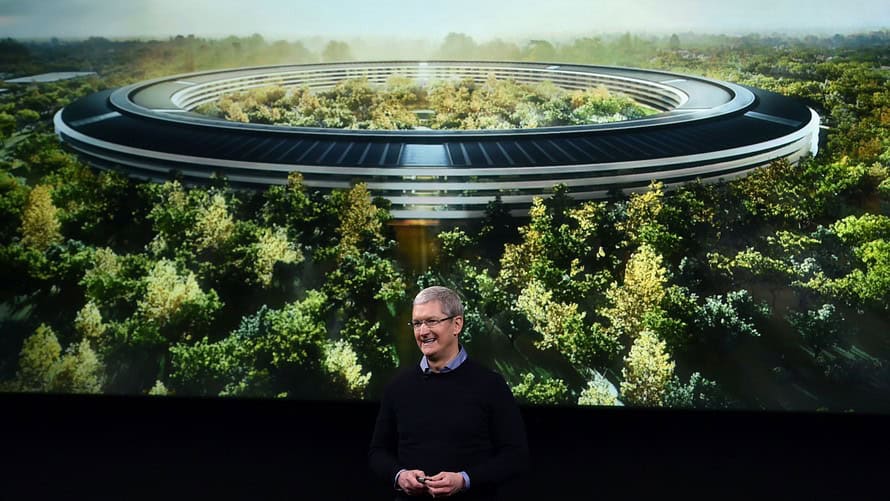
Companies experience a life cycle similar to people, going through changes as they age. This is happening now with Apple Inc., which rather than losing its edge is really just maturing.
That’s good news for investors. Consider that Apple’s AAPL, +0.42% peer Microsoft MSFT, +0.76% has proven that life exists for middle-aged tech stocks in a big way. Microsoft stock has soared roughly 40% in the last 12 months to trounce the 11% or so return of the benchmark S&P 500 SPX, +1.08% in the same period. And over the last three years, Microsoft shares have soared around 115%, trouncing both Apple’s 45% return in the same period and the S&P 500’s 21% or so gain.
Microsoft has performed notably without a fancy new product in a new marketplace. Instead, like the mature operation it is, the company has cut some bad habits, focused on its strengths, and planned better to keep what it has fought over decades to earn.
This might not sway a 20-something tech critic. But with Microsoft’s market value neck-and-neck with both Alphabet GOOGL, +0.20% and Amazon.com AMZN, +0.52% , the stuffed shirts on Wall Street certainly like what they see.
Apple’s evolution mirrors Microsoft’s in many ways. While many investors worry that Apple is losing its grip on innovation and growth, they are missing the broader story of this tech stock becoming a more mature company that may not move as fast but still has plenty left to offer.
Here’s what Apple shares in common with Microsoft, and why Apple shareholders should be pleased:
1. Embracing the “toll taker” mentality
Microsoft had some growing pains in the last decade or so, but than try to break into new markets, it leveraged its already impressive operations to become a profitable cloud-computing powerhouse.
While Apple was able to ride the mobile wave to great success, a similar move is currently under way as higher-ups realize that wave has crested. Case in point: IDC noted that the global smartphone market will contract for the second consecutive year, and iconic tech VC Mary Meeker gave her annual Internet Trends report showing worldwide smartphone shipment growth has flatlined.
What to do? Apple could try to divine the next evolution of device trends, or it could learn from Microsoft’s early mistakes and use its current scale to create consistent revenue streams.
That’s exactly what Apple is doing with its Services segment. With a strong base of installed iPhones and iPads, Apple is working to grab dollars from folks using iTunes, Apply Pay, and other offerings. The services segment grew an impressive 31% year-over-year in Apple’s most recent quarter, running at a $35 billion annual rate or so. That’s more than two times the projected top-line revenue of Netflix NFLX, +0.58% this fiscal year.
To be sure, collecting fees from song downloads isn’t as sexy as creating original content, but it can be much more reliable — and profitable — for Apple shareholders.
2. Returning capital in earnest
As of this moment, Apple is the only member of the so-called FAANG family of stocks — FB, -1.80% Amazon.com, Apple, Netflix, and Google parent Alphabet — that pays dividends.
In fact, newbie investors may be surprised to learn that the current dividend cycle for Apple that started back in 2012 wasn’t the first foray into paying back shareholders a bit of its profits; the company paid regular dividends from 1987 to 1995.
In this age of no-profit “unicorns,” the stability and long-term total returns you get from a dividend payer is compelling. Consider that while Apple’s stock has gained 190% since June 2013, total return including dividends is 270%. Similarly, Microsoft is up 180% in the last five years without dividends, and 220% including dividends.
Additionally, five years ago Apple had more than 900 million shares of common stock outstanding — which equates to roughly 6.3 billion shares accounting for the 2014 7-for-1 split. Yet due to aggressive buybacks, currently 4.9 billion shares of common stock are outstanding. That’s a more than 20% reduction in shares in just five years.
Microsoft’s details aren’t as stark, with about 8.3 billion common shares in mid-2013 and around 7.7 billion currently — a 7% reduction. But Microsoft also shows a strong commitment to buybacks over time to reduce supply and boost the share price.
Such financial tactics are sometimes derided by growth investors as playing games with Wall Street to spackle over unimpressive fundamentals. But from a shareholder value perspective and accounting for total returns, these methods have been successful.
3. Embracing execution
It’s hard to fill the shoes of an icon, and both Microsoft’s Bill Gates and Apple’s Steve Jobs forever left their mark on Wall Street and Main Street with their innovation and exploration of technology’s promise. But rather than name dynamic heirs as CEO, both companies instead focused on insiders who were detail-oriented and knew how to execute, Satya Nadella at Microsoft and Apple’s Tim Cook.
This was a huge risk for Microsoft at the time. But Nadella won over Wall Street, which was at first hoping for an outsider who could shake things up at Microsoft. Nadella has succeeded through soft skills like making employees feel valued, and being thoughtful about new opportunities and past mistakes before simply diving in.
A similar and more thoughtful mindset has been brought to Apple. Tim Cook is in many ways the anti-Jobs, known for his silence in meetings instead of his big personality. He was the head of procurement, a good negotiator with amazing supply-chain experience who was able to manage the daunting task of getting all those flashy new iPhones built and delivered.
Will either CEO preside over a “rebirth” of their company is the wrong question. Simply being good stewards of the empire that is built and delivering reliable success is quite an accomplishment. And judging by the recent stock price of both companies, a profitable one.

